Quantitative Changes in Various Nutrient Ratios in Fodder Plants as an Effect of Compost and Fly Ash Application
Abstract
1. Introduction
2. Materials and Methods
2.1. Experimental Design
2.2. Analysis of Plant and Soil
2.3. Statistical Analysis
3. Results
3.1. Lupine
3.2. Oat
4. Discussion
5. Conclusions
Author Contributions
Funding
Institutional Review Board Statement
Informed Consent Statement
Data Availability Statement
Conflicts of Interest
References
- Capstaff, N.M.; Miller, A.J. Improving the yield and nutritional quality of forage crops. Front. Plant Sci. 2018, 9, 535. [Google Scholar] [CrossRef] [PubMed]
- Panasiewicz, K.; Faligowska, A.; Szymańska, G.; Koziara, W.; Szukała, J.; Poniatowska, J. Yielding of narrow-leaved lupin depending on varieties, sowing method and sowing rate. Fragm. Agron. 2018, 35, 72–80. [Google Scholar]
- Singh, V.K.; Sinha, A.K.; Takawle, P.S.; Shindey, D.N.; Srivastav, M.K. Evaluation of different oat varieties for green fodder and seed production yields. Int. J. Adv. Multidiscip. Res. 2018, 5, 3668–3670. [Google Scholar]
- Dangi, S. Oat as Green Fodder and Its Intercropping Benefits: A Review. Agric. Rev. 2021, 168, 1–7. [Google Scholar] [CrossRef]
- Micek, P.; Zając, T.; Borowiec, F. Protective value of oat and its chemical composition and nutritive value as green forage or silage. Bull. Inst. Breed. Acclim. Plants 2003, 229, 349–357. [Google Scholar]
- Kumar, D.; Singh, M.; Yadav, M.R.; Makarana, G.; Kushwaha, M.; Dutta, S.; Bhattacharjee, S.; Rajesh, B. Growth and yield performance of fodder oats (Avena sativa) grown under different nutrient management practices. Indian J. Agric. Sci. 2022, 92, 267–272. [Google Scholar]
- Kumar, K.; Soni, A. Elemental ratio and their importance in feed and fodder. Int. J. Pure Appl. Biosci. 2014, 2, 154–160. [Google Scholar]
- Jakubus, M.; Bakinowska, E. Quantitative changes in various nutrient ratios in cultivated plants in relation to fertilisation. J. Elem. 2020, 25, 1155–1174. [Google Scholar] [CrossRef]
- Antonkiewicz, J.; Popławska, A.; Kołodziej, B.; Ciarkowska, K.; Gambus, F.; Bryk, M.; Babula, J. Application of ash and municipal sewage sludge as macronutrient sources in sustainable plant biomass production. J. Environ. Manag. 2020, 264, 110450. [Google Scholar] [CrossRef]
- Klikocka, H.; Marks, M.; Barczak, B.; Szostak, B.; Podlesna, A.; Podlesny, J. Response of spring wheat to NPK and s fertilization. The content and uptake of macronutrients and the value of ionic ratios. Open Chem. 2018, 16, 1059–1065. [Google Scholar] [CrossRef]
- Ostrowska, A.; Porębska, G. The content of calcium and magnesium and the Ca:Mg ratio in cultivated plants in the context of human and animal demand for nutrients. J. Elem. 2017, 22, 995–1004. [Google Scholar] [CrossRef]
- Rady, M.M.; Semida, W.M.; Hemida, K.A.; Abdelhamid, M.T. The effect of compost on growth and yield of Phaseolus vulgaris plants grown under saline soil. Int. J. Recycl. Org. Waste Agric. 2016, 5, 311–321. [Google Scholar] [CrossRef]
- Rietra, R.P.J.J.; Heinen, M.; Dimkpa, C.O.; Bindraban, P.S. Effects of nutrient antagonism and synergism on yield and fertilizer use efficiency. Commun. Soil Sci. Plant Anal. 2017, 48, 1895–1920. [Google Scholar] [CrossRef]
- Awasthi, M.K.; Wang, Q.; Chen, H.; Liu, T.; Awasthi, S.K.; Duan, Y.; Varjani, S.; Pandey, A.; Zhang, Z. Role of compost biochar amendment on the (im)mobilization of cadmium and zinc for Chinese cabbage (Brassica Rapa L.) from contaminated soil. J. Soil Sedim. 2019, 19, 3883–3897. [Google Scholar] [CrossRef]
- Selvi, A.; Rajasekar, A.; Theerthagiri, J.; Ananthaselvam, A.; Sathishkumar, K.; Madhavan, J.; Rahman, P.K.S.M. Integrated remediation processes towards heavy metals removal/recovery from various environments—A review. Front. Environ Sci. 2019, 7, 66. [Google Scholar] [CrossRef]
- Nadeem, F.; Hanif, M.A.; Majeed, M.I.; Mushtaq, Z. Role of macronutrients and micronutrients in the growth and development of plants and prevention of deleterious plant diseases-a comprehensive review. Int. J. Chem. Biochem. 2018, 14, 1–22. [Google Scholar]
- WRB (World Reference Base for Soil Resources) 2014; Update, World Soil Resources Reports, 106; FAO: Rome, Italy, 2015.
- Directive 86/278/EWG. Available online: https://eur-lex.europa.eu/legal-content/EN/TXT/?uri=celex%3A31986L0278 (accessed on 28 April 2022).
- Jakubus, M.; Graczyk, M. The Effect of Compost and Fly Ash Treatment of Contaminated Soil on the Immobilisation and Bioavailability of Lead. Agronomy 2021, 11, 1188. [Google Scholar] [CrossRef]
- Ostrowska, A.; Gawliński, S.; Szczubialka, Z. Methods for Analysis and Evaluation of Soil and Plant Properties, 1st ed.; IOŚ Warszawa: Warszawa, Poland, 1991; pp. 158–167. (In Polish) [Google Scholar]
- Scheffé, H. The Analysis of Variance; Wiley: Hoboken, NJ, USA, 1999; p. 477. ISBN 978-0-471-34505-3. [Google Scholar]
- Maćkowiak, C.L.; Myer, R.O.; Blount, A.R.; Foster, J.L.; Barnett, R.D. Yield and mineral concentration of southeastern United States oat cultivars used for forage. J. Plant Nutr. 2011, 34, 1828–1842. [Google Scholar] [CrossRef]
- Chen, H.; Awasthi, S.K.; Liu, T.; Duan, Y.; Zhang, Z.; Awasthi, M. Compost biochar application to contaminated soil reduces the (im)mobilization and phytoavaialbility of lead and copper. J. Chem. Technol. Biotechnol. 2020, 95, 408–417. [Google Scholar] [CrossRef]
- Järvan, M.; Vettik, R.; Adamson, A. Assessment of plant nutrients dynamic in organically and conventionally managed soils by means of different extraction methods. Acta Agric. Scand. Sect. B Soil Plant Sci. 2017, 67, 191–201. [Google Scholar] [CrossRef]
- Moretti, S.M.L.; Bertoncini, E.I.; Abreu-Junior, C.H. Carbon mineralization in soils irrigated with treated swine wastewater. J. Agric. Sci. 2017, 9, 19–29. [Google Scholar] [CrossRef][Green Version]
- Jakubus, M.; Bakinowska, E.; Gałka, B. The quantitative changes of nutrients in two contrasting soils amended with sewage sludge compost evaluated by various statistical tools. Acta Agric. Scand. Sect. B Soil Plant Sci. 2018, 68, 39–49. [Google Scholar] [CrossRef]
- Agegnehu, G.; Nelson, P.N.; Bird, M.I. Crop yield, plant nutrient uptake and soil physicochemical properties under organic soil amendments and nitrogen fertilisation on Nitisols. Soil Till Res. 2016, 160, 1–13. [Google Scholar] [CrossRef]
- Anwar, Z.; Irshad, M.; Mahmood, Q.; Hafeez, F.; Bilal, M. Nutrient uptake and growth of spinach as affected by cow manure co-composted with popular leaf litter. Int. J. Recycl. Org. Waste Agric. 2017, 6, 79–88. [Google Scholar] [CrossRef]
- Papafilippaki, A.; Paranychianakis, N.; Nikolaidis, N.P. Effects of soil type and municipal solid waste compost as soil amendment on Chichorium spinosum (Spiny Chicory) grow. Sci. Hortic. 2015, 195, 195–205. [Google Scholar] [CrossRef]
- Mahler, R.L. Nutrients Plants Require for Growth; University of Idaho: Moscow, ID, USA, 2004; Available online: https://www.extension.uidaho.edu/publishing/pdf/CIS/CIS1124.pdf (accessed on 28 April 2022).
- Prasad, P.N.S.; Subbarayappa, C.T.; Reddy, M.M.; Meena, H.M. Development of critical limits for different crops grown in different soils and its use in optimizing fertilizer rates. Int. J. Curr. Microbiol. Appl. Sci. 2017, 6, 241–249. [Google Scholar] [CrossRef]
- Zeng, Q.; Liu, Y.; Fang, Y.; Ma, R.; Lal, R.; An, S.; Huang, Y. Impact of vegetation restoration on plants and soil C:N:P stoichiometry on the Yunwu mountain reserve of China. Ecol. Eng. 2017, 109, 92–100. [Google Scholar] [CrossRef]
- Feng, X.; Wang, R.; Yu, Q.; Cao, Y.; Zhang, Y.; Yang, L.; Dijkstra, F.A.; Jiang, Y. Decoupling of plant and soil metal nutrients as affected by nitrogen addition in a meadow steppe. Plant Soil 2019, 443, 337–351. [Google Scholar] [CrossRef]
- Li, M.; Huang, C.; Yang, T.; Drosos, M.; Wang, J.; Kang, X.; Liu, F.; Xi, B.; Hu, Z. Role of plant species and soil phosphorus concentrations in determining phosphorus: Nutrient stoichiometry in leaves and fine roots. Plant Soil 2019, 445, 231–242. [Google Scholar] [CrossRef]
- De Conti, L.; Ceretta, C.A.; Tiecher, T.L.; da Silva, L.O.S.; Tassinari, A.; Somavilla, L.M.; Mimmo, T.; Cesco, S.; Brunetto, G. Growth and chemical changes in the rhizosphere of black oat (Avena strigosa) grown in soils contaminated with copper. Ecotoxicol. Environ. Safe 2018, 163, 19–27. [Google Scholar] [CrossRef]
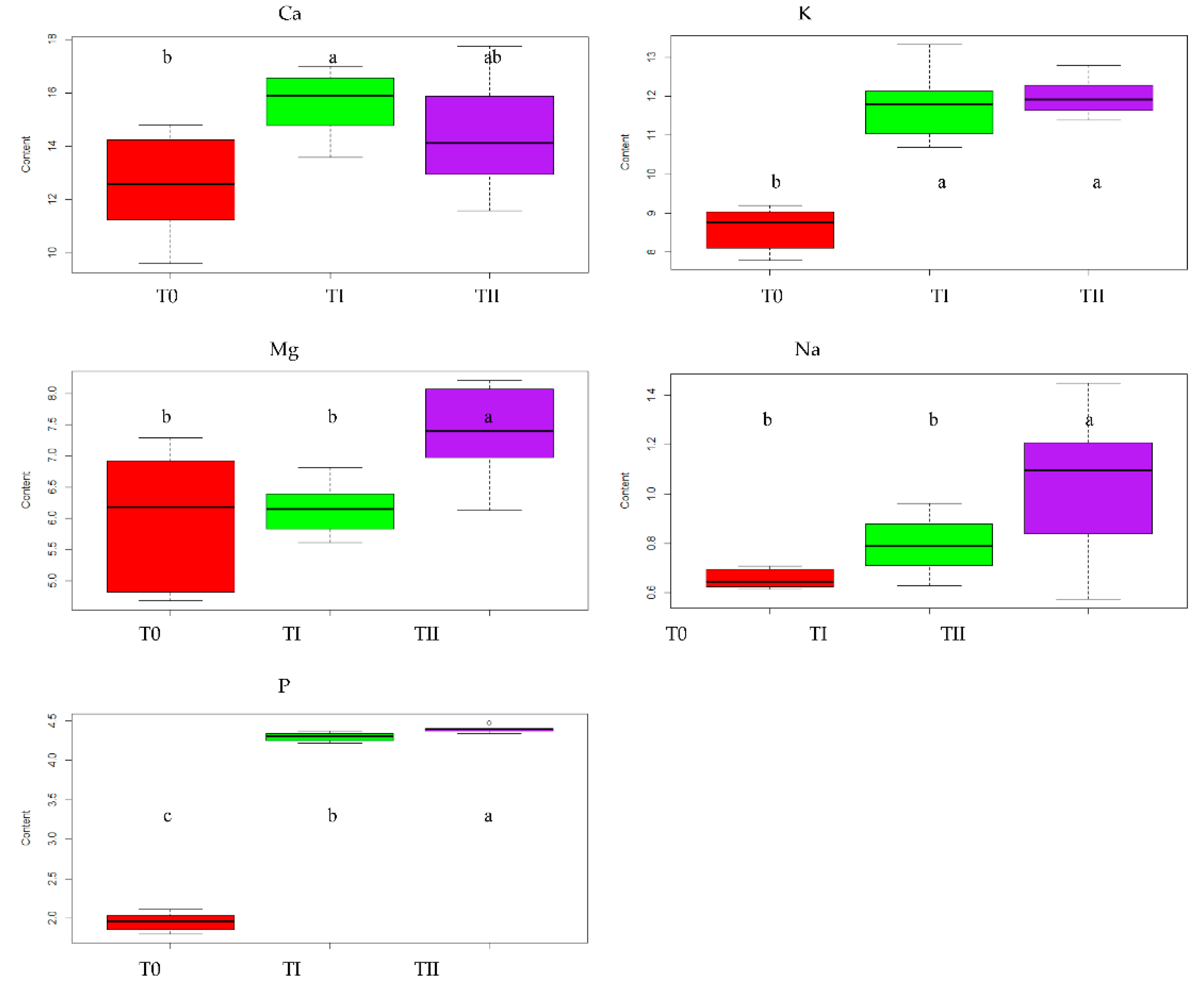
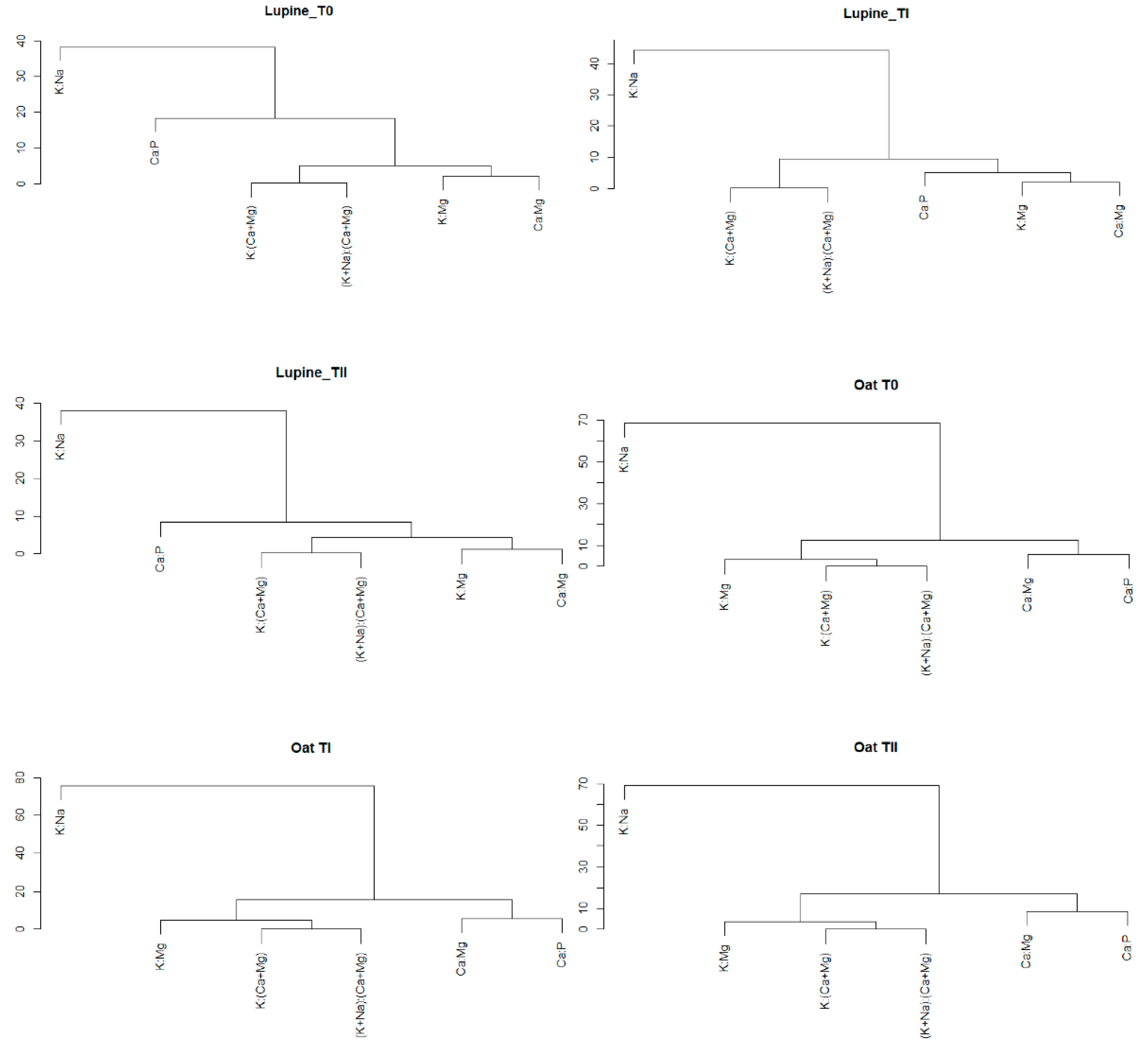

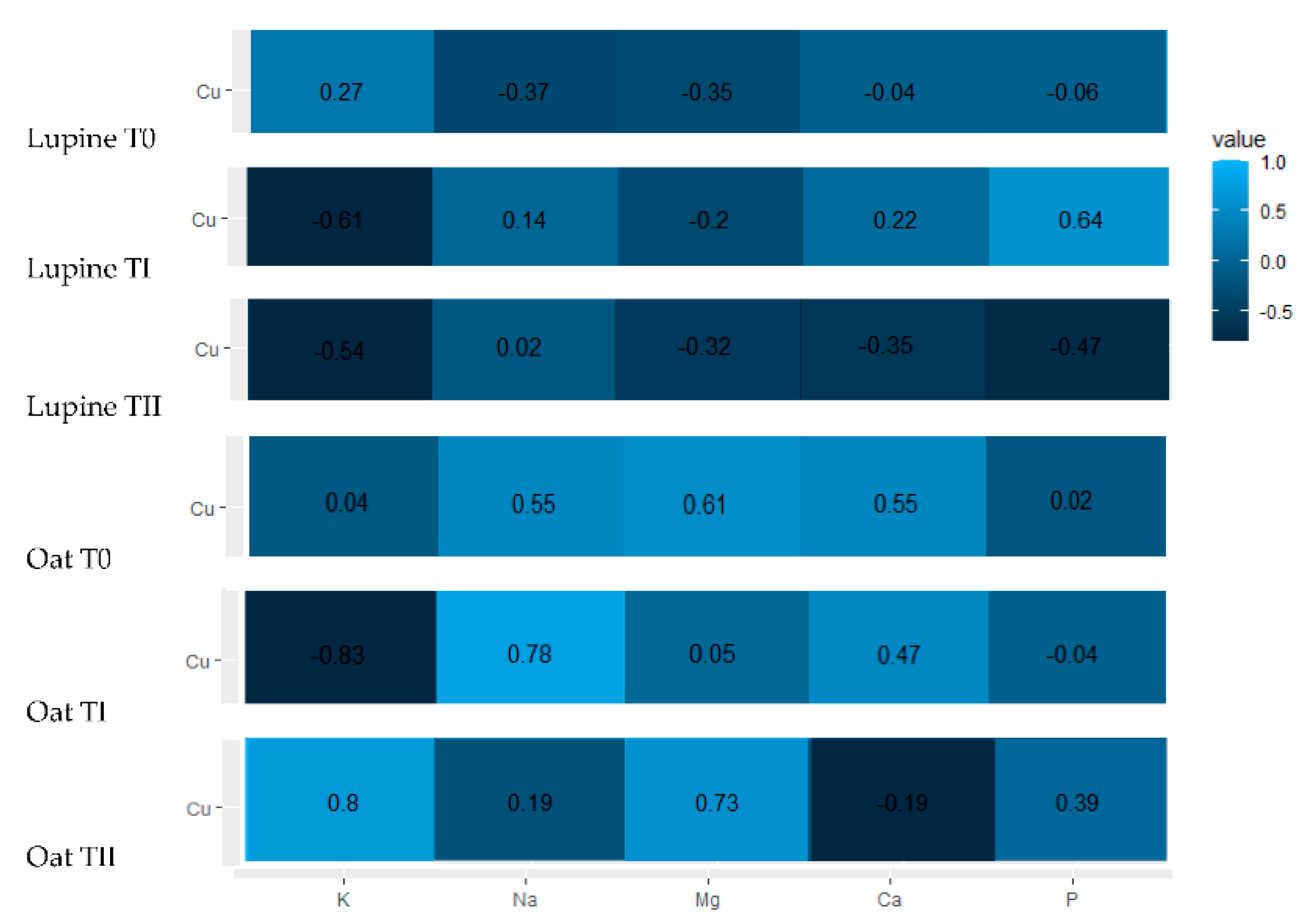
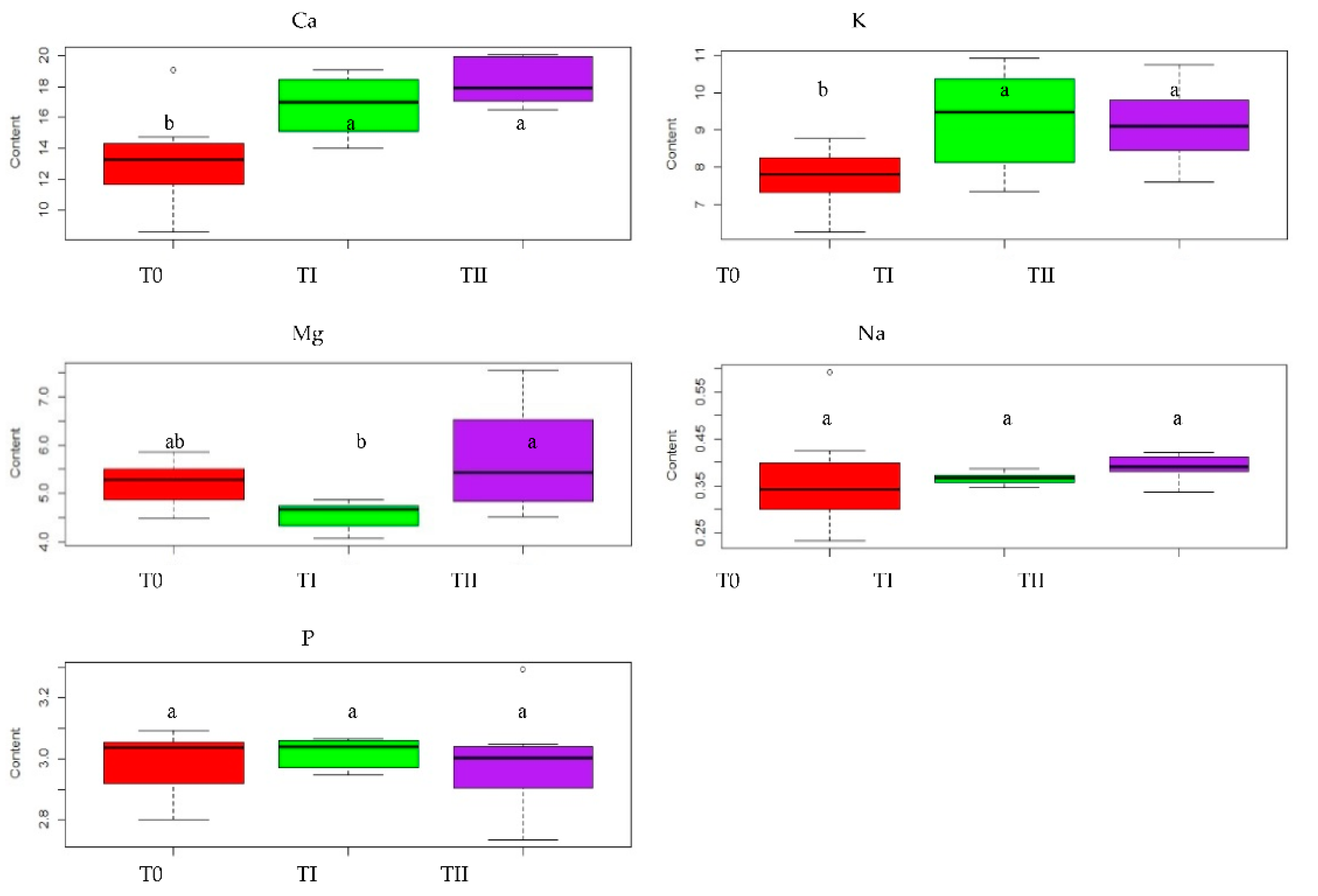
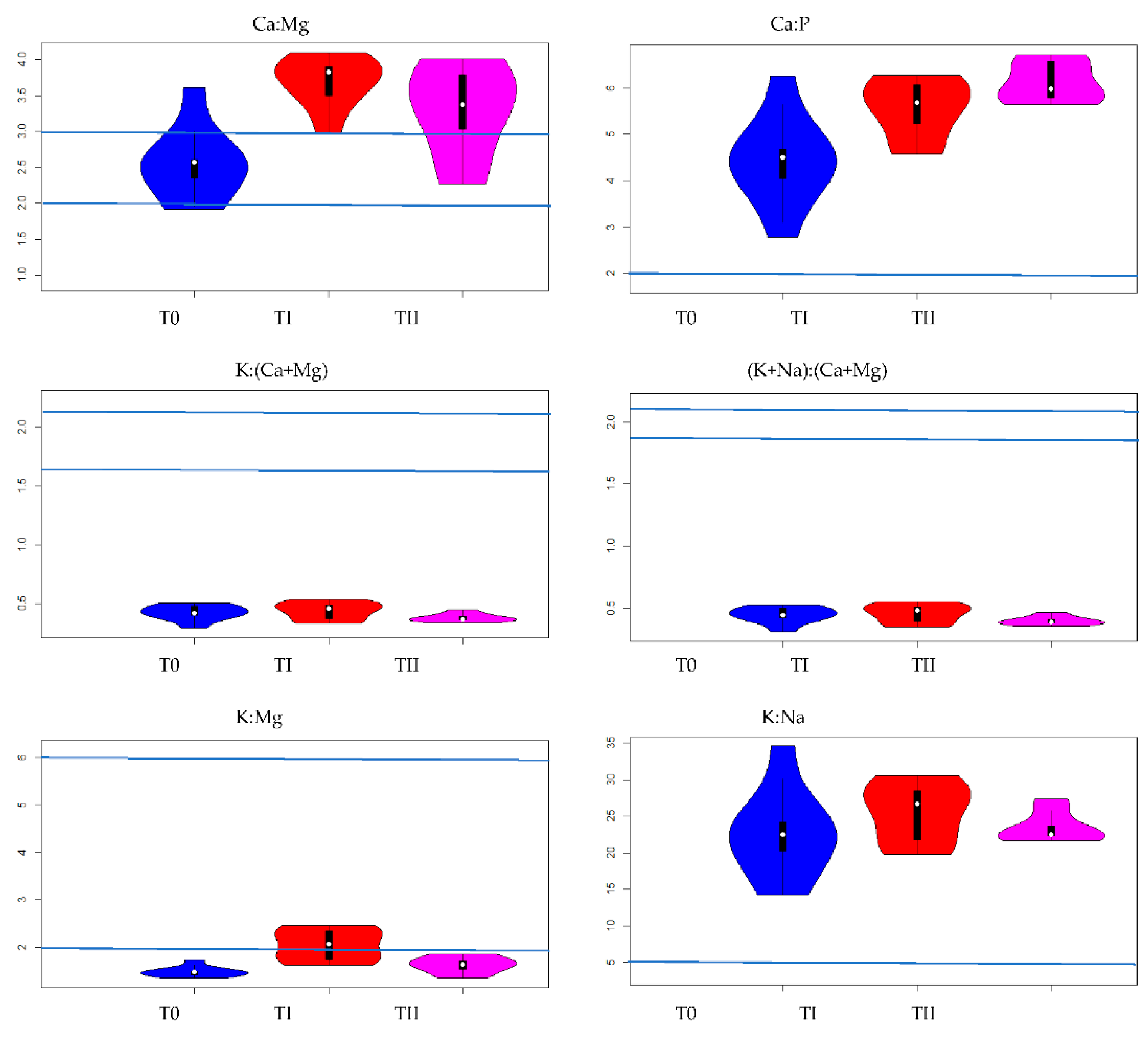
| Parameter | Soil | Compost | Fly Ash |
|---|---|---|---|
| pH | 7.0 | 6.8 | 13.7 |
| TOC (g·kg−1) | 16.8 | 181.3 | n.d. 1 |
| PTot (g·kg−1) | 1.8 | 3.8 | 10.8 |
| KTot (g·kg−1) | 2.9 | 3.5 | 3.7 |
| MgTot (g·kg−1) | 3.5 | 1.5 | 8.4 |
| CaTot (g·kg−1) | 13.4 | 18.4 | 18.4 |
| NaTot (g·kg−1) | 0.2 | 1.2 | 8.8 |
| CuTot (mg·kg−1) | 200 | 33 | 44 |
| Macronutrient | Lupin | Oat |
|---|---|---|
| Ca | 0.00825 ** | 0.00069 *** |
| K | 7.57 × 10−10 *** | 0.01371 * |
| Mg | 0.00299 ** | 0.01281 * |
| Na | 0.00159 ** | 0.66402 |
| P | <2 × 10−16 *** | 0.85213 |
| Nutrient Ratios | Lupin | Oat |
|---|---|---|
| Ca:Mg | 0.00053 *** | 0.00076 *** |
| Ca:P | 5.66 × 10−8 *** | 0.00049 *** |
| K:(Ca+Mg) | 0.01822 * | 0.175 |
| (K+Na):(Ca+Mg) | 0.00841 ** | 0.162 |
| K:Mg | 0.00145 * | 0.00019 *** |
| K:Na | 0.271 | 0.423 |
| Treatment | Equation |
|---|---|
| TI | Na = 0.240 + 0.001·Cu |
| K = 23.691 − 0.067·Cu | |
| TII | K = −3.028 + 0.053·Cu |
| Mg = −6.139 + 0.051·Cu | |
| T0 | K:Na = 120.545 − 0.509·Cu |
| TI | K:(Ca+Mg) = 1.353 − 0.004·Cu |
| (K+Na):(Ca+Mg) = 1.375 − 0.004·Cu K:Mg = 5.320 − 0.015·Cu K:Na = 72.787 − 0.219·Cu | |
| TII | K:(Ca+Mg) = −0.001 + 0.002·Cu |
| (K+Na):(Ca+Mg) = 0.018 + 0.016·Cu | |
| K:Na = −3.736 + 0.117·Cu |
Publisher’s Note: MDPI stays neutral with regard to jurisdictional claims in published maps and institutional affiliations. |
© 2022 by the authors. Licensee MDPI, Basel, Switzerland. This article is an open access article distributed under the terms and conditions of the Creative Commons Attribution (CC BY) license (https://creativecommons.org/licenses/by/4.0/).
Share and Cite
Jakubus, M.; Graczyk, M. Quantitative Changes in Various Nutrient Ratios in Fodder Plants as an Effect of Compost and Fly Ash Application. Int. J. Environ. Res. Public Health 2022, 19, 8136. https://doi.org/10.3390/ijerph19138136
Jakubus M, Graczyk M. Quantitative Changes in Various Nutrient Ratios in Fodder Plants as an Effect of Compost and Fly Ash Application. International Journal of Environmental Research and Public Health. 2022; 19(13):8136. https://doi.org/10.3390/ijerph19138136
Chicago/Turabian StyleJakubus, Monika, and Małgorzata Graczyk. 2022. "Quantitative Changes in Various Nutrient Ratios in Fodder Plants as an Effect of Compost and Fly Ash Application" International Journal of Environmental Research and Public Health 19, no. 13: 8136. https://doi.org/10.3390/ijerph19138136
APA StyleJakubus, M., & Graczyk, M. (2022). Quantitative Changes in Various Nutrient Ratios in Fodder Plants as an Effect of Compost and Fly Ash Application. International Journal of Environmental Research and Public Health, 19(13), 8136. https://doi.org/10.3390/ijerph19138136







